Step by Step Soil Prep Guide
-
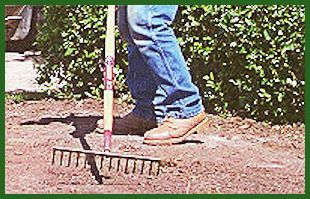 Clear
the site of all building materials
(wood, cement, bricks, etc...) as well as
any buried stumps, rocks, stones or other
debris that are any larger than 2 inches in
diameter. Clear
the site of all building materials
(wood, cement, bricks, etc...) as well as
any buried stumps, rocks, stones or other
debris that are any larger than 2 inches in
diameter.
-
Rough grade the entire
area to eliminate any drainage problems on
the property. This would include sloping
the grade away from building foundations,
eliminating or reducing severe slopes and
filling low-lying areas. A tractor-mounted
blade and/or box are most often used for
rough grading, but if the area is small, it
can be done with hand tools. The rough
grading, will probably uncover more debris
that should be removed.
-
Initial tilling to a
depth of at least 2 inches, should be
completed prior to adding any topsoil or
soil amendments. This will control most
annual weeds, alleviate subsoil compaction,
permit a bonding of the topsoil to the
subsoil and improve root penetration as well
as air exchange and water movement.
-
Add
topsoil to achieve a total topsoil
depth of 4-6 inches, after firming. The
topsoil should be a loamy sand, sandy loam,
clay loam or other soil suitable for the
area.
-
Test soil for pH and nutrients
to determine if any pH correcting
materials or nutrients are required.
Acidic soils a pH of less
than 6 can be improved with the addition of
lime. The type (or source) and amount
applied will be determined by the level of
acidity and should be based on the
recommendations of a professional.
 Alkaline soils
a pH of 8 and higher
can be improved with sulphur. As with
acidic soil correcting materials, the type
and amount of materials needed will be
determined by the level of acidity and
should be based on the recommendations of a
professional. Alkaline soils
a pH of 8 and higher
can be improved with sulphur. As with
acidic soil correcting materials, the type
and amount of materials needed will be
determined by the level of acidity and
should be based on the recommendations of a
professional.
-
Apply fertilizer to
correct any deficiencies following the
product's recommended rate. To avoid root
injury to new turfgrass, the fertilizer
should be raked into the top 3-4 inches.
-
Finish grade the entire
site, maintaining the rough grading contours
and slopes, with a tractor-mounted box blade
for large areas or a heavy-duty rake for
smaller sites.
-
Roll the area with a
lawn roller one-third full of water to firm
and settle surface. Low spots should be
filled to match the surrounding grade
surface. If time permits, allow area to
settle further with rainfall or by applying
irrigation.
With this degree of careful preparation your
lawn will be beautiful and require less
maintenance.
How to Determine the Size of Your Lawn
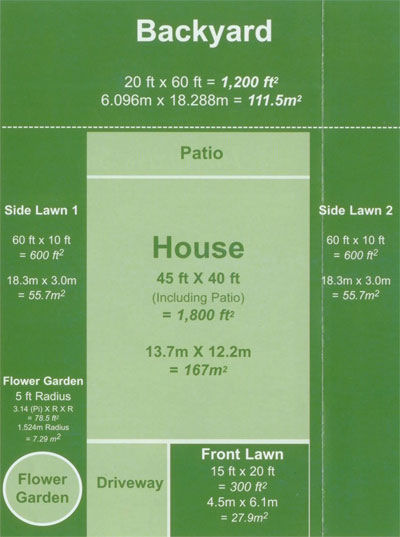 To calculate your actual total lawn area
follow the steps noted below and do a sketch
with the length, width and any unusual features
noted. To calculate your actual total lawn area
follow the steps noted below and do a sketch
with the length, width and any unusual features
noted.
Step
1
Determine total square feet of your property
Step 2
Determine total square feet of your non-lawn
areas not covered by grass (i.e. house, flower
garden, driveway, patio, etc...)
Step 3
From the total square feet subtract the total
"non-lawn" area to determine the area that
requires turfgrass/sod.
|
Location |
| Backyard |
1,200 sq feet |
| Side Lawn 1 |
600 sq feet |
| Side Lawn 2 |
600 sq feet |
| Front Lawn |
300 sq feet |
| Total Lawn Area |
2,700 sq feet |
| Flower Garden |
(79) sq feet |
| Total Sod Needed |
2,621 sq feet |
| Plus 5% |
131 sq feet |
| Total |
2,752 sq feet |
Be sure to measure carefully, Double check
your measurements. Always round up or add about
5%-10% extra to make sure you have enough
sod for angles and cuts. Better to
have a few extra square feet than to run out
before you finish the installation.
|
Measuring Geometric Shapes |
|
Square and Rectangle |
Circle |
|
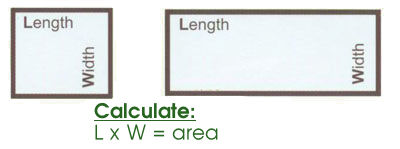 |
 |
|
Triangle |
Trapezoid |
|
 |
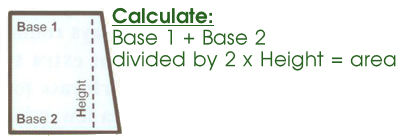 |
Post Installation Care of Turfgrass/Sod

Fertilizer
The type and quality of fertilizer required for
your lawn will depend on your grass variety. Cool
and warm season grasses vary as do their nutrient
requirements.
Mowing
The turfgrass can be mowed when it is rooted. Be
sure to remove no more than 1/3 of the grass blade.
The actual height of the cut varies depending on
whether the grass is a cool or warm season and the
type of grass.
Keep your mower blades sharp. Dull blades tear
the grass blade instead of cutting it cleanly.
These small rips in the turfgrass/sod tissue can
caused the grass to lose more water, increase
irrigation needs, create stress and make the lawn
more vulnerable to diseases.
Grass
Clippings
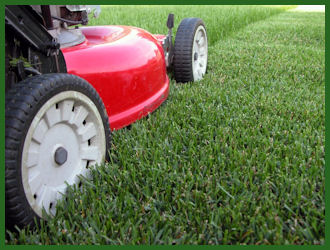 Contrary to popular
belief, they do not cause thatch. (Thatch usually
occurs only when turf/sod is excessively fertilized
and soil is compacted, cool and moist.) If you
follow the 1/3 cutting rule grass clippings won't
smother the grass plants. They will dry out and
work their way down to the soil surface. These
clippings return nutrients to the soil, resulting in
less fertilizer use. They also cool the soil and
help it retain water. Contrary to popular
belief, they do not cause thatch. (Thatch usually
occurs only when turf/sod is excessively fertilized
and soil is compacted, cool and moist.) If you
follow the 1/3 cutting rule grass clippings won't
smother the grass plants. They will dry out and
work their way down to the soil surface. These
clippings return nutrients to the soil, resulting in
less fertilizer use. They also cool the soil and
help it retain water.
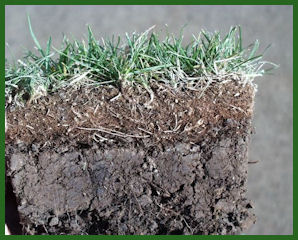
Thatch
Thatch is a layer of dead and decomposing plant
tissue that forms above the soil. A thin 1/2 inch
layer is beneficial to a lawn. It protects plant
crowns and reduces compaction. But if the layer
gets too thick, water, air and fertilizer can't get
through to the soil and grass roots. Runoff
increases and dry spots appear. Or when it's wet,
the thatch can remain saturated and suffocate
roots. Thatch usually occurs on turf/sod that has
been heavily fertilized, and is most common on
poorly drained, compacted and acidic soils.
Some species of lawn grasses are more prone to
thatch problems than others. Severe thatch problems
left unattended may eventually require the use of a
dethatching machine. To prevent or minimize thatch
problems, core aeration is an option depending on
your situation.
 Aeration Aeration
Core
aerators punch small holes in the lawn allowing air
and moisture to penetrate through the holes. It is
most effective in late summer when temperatures are
starting to fall and the soil is only slightly
moist.
After aeration, leave the soil cores on the
surface to dry. Then rake them to distribute the
soil down through the grass to mix with and dilute
the thatch. The mixing action of core aeration is
similar to that provided by earthworms. Core
aeration can also help increase water infiltration
on compacted soils.
|